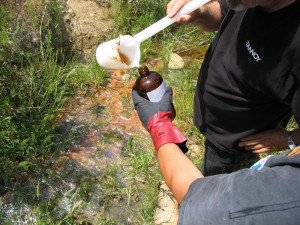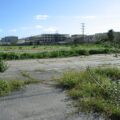These question were sent in to the Department of Toxic Substances Control by reporter Michael Collins on August 16, 2010:
#1) Questions for Rick Brausch and Maziar Movassaghi regarding the Runkle Response Plan:
1A) Our Response Plan comments and questions, that DTSC has not responded to, are available at http://enviroreporter.com/files/KB41docs.pdf
• Why was the decision been made to post the Runkle Response Plan without answering the Response Plan comments by numerous individuals and organizations (including Southwick’s group and EnviroReporter.com) that DTSC has had since February 2009?
• Why didn’t DTSC inform the residents, organizations and media that had made comments that the department had responded to them?
• Why DTSC didn’t answer any of our questions in 28 pages of comments?
• Why did DTSC choose to mischaracterized our comments, and those of other commenters, in the Response Plan document? What good does that do to the success of the process of public involvement that is mandated by law?
• Will DTSC ever respond to our comments?
1B) Additional questions about Runkle Response Plan:
On page 5/14, the Plan says “Samples will be collected in drainages and to confirm previously reported elevated results (90Sr > 1.7 pCi/g).”
• Could DTSC cite/source where it came up with this figure of 1.7 pCi/g?
As I understand it, “elevated results” means over background. As I wrote in the 1/19/2006 LA CityBeat article “Hot Property,” In July 1995, the U.S. EPA estimated that the average local background concentration for Sr-90 in the Santa Susana hills area was 0.052 picocuries per gram (pCi/g) for soil, which is a measurement of the normal presence of the radionuclide.
The 0.052 picocuries per gram figure comes from https://www.enviroreporter.com/files/7-95_EPA_Sr-90_background_for_area.pdf. The Argonne National Laboratory says of Sr-90 in soil “most levels fall between 0.05 and 0.5 pCi/g, with 0.1 pCi/g as a general average” according to http://www.evs.anl.gov/pub/doc/Strontium.pdf
• Why is DTSC using the figure of 1.7 pCi/g as the baseline Sr-90 figure in the Runkle Canyon Response Plan, when it is 32.69 times background for Runkle Canyon? Is DTSC not aware that this skews results making samples found over 0.052 pCi/g, but under 1.7 pCi/g not “elevated”? This baseline number of 1.7 pCi/g is 17 times what is commonly known for the average amount of Sr-90 in American soil. What is the scientific justification for this?
1C) On page 5/14, the Plan says:
DTSC reviewed all of the comments and noted that many of the same (or substantively the same) comments were provided by different reviewers.
DTSC has summarized the comments (in italics) related to the Response Plan activities and its responses to those comments are provided beneath each summarized set of comments.
• Again, why did DTSC not answer my questions posed in http://enviroreporter.com/files/KB41docs.pdf that were submitted to the department 1.5 years ago? Why did DTSC simply summarize a few points of several commenters, saying this represented the questions asked of each of them, when a review of my questions shows that these characterizations are not accurate or true in relation to my questions and comments?
1D) Regarding “Characterization 1)” on page 6/14:
• Does DTSC know which company KB Home has chosen to do the resampling for Sr-90 in soil?
1E) On page 10/14, DTSC writes:
In the immediate area, natural arsenic concentrations range from 2 to 10 mg/kg. DTSC has evaluated hundreds of sites in southern California, where arsenic is typically found between 1 and 20 mg/kg. DTSC has determined that arsenic levels up to 12 mg/kg would not pose a risk to human health.
Yet on page 2/10 of a July 22, 2010 DTSC letter to Runkle Canyon, LLC’s Eric Hoffman, DTSC’s Project Director Mark Malinowski writes:
Surface Water
Community members expressed concerns regarding some surface water samples that they had collected which exhibited some higher metals concentrations than samples collected during previous and subsequent investigations. To evaluate current conditions DTSC staff collected two samples after a rainstorm and analyzed the samples for metals concentrations. Surface water flow at the site is ephemeral so sampling runoff is only possible directly after rainstorms. These samples contained relatively low concentrations of metals which are comparable to concentrations detected during previous investigations. Arsenic, vanadium and chromium were not detected in the surface water samples. Analytical data from these two samples validate the analytical data from previous investigations; consequently, DTSC is not requiring additional surface water investigation.
• What “previous and subsequent investigations” (in the first sentence preceding) is DTSC referring to?
• Is DTSC not aware that no previous investigation of Runkle Canyon’s surface water was ever reported? I wrote about this in Los Angeles CityBeat/ValleyBeat – June 21, 2007 in the article “The Radiation Rangers” where I wrote (and available at https://www.enviroreporter.com/investigations/runkle-canyon-investigation/the-radiation-rangers//3/):
In the body of the report, Miller Brooks writes that Title 22 metals were “below state and federal regulatory limits (see Table 1).” Title 22 metals are toxic metals listed in Title 22 of the state health code. But the report’s Table 1 actually says that the Title 22 metals in the surface water sample were “not analyzed.” Oddly, the Title 22 metals were tested in the asphalt but not in the water.
• Why did DTSC make this factually inaccurate statement in its July 22, 2010 letter to Hoffman? Did DTSC not know that the Runkle Canyon EIR had no testing of surface water ever reported in the EIR and that the community, and then city, were the first to sample and test it?
In a subsequent article for LA CityBeat called “Spin Cycle” (August 23, 2007) available at https://www.enviroreporter.com/spincyclelacb, we reported that, despite City of Simi Valley spin, their tests of the same Runkle Canyon surface water produced even higher results:
[T]he city’s tests came back with an even higher amount of arsenic in the water than the Rangers did. The reading for arsenic, which causes bladder and lung cancers as well as diabetes, developmental problems, gastrointestinal illness and heart disease, was 25 percent higher. That translates to 26,478 times tap water’s PRG and 47,000 times California’s “public health goal” for the toxin in drinking water.
Another regulated heavy metal found by the Rangers in Runkle Canyon water, barium, was detected at levels 233 percent higher than the citizens’ sampling. Nickel came in 33 percent higher and vanadium 55 percent more elevated than the earlier tests. That is 2.8 times the “notification level” which are “health-based advisory levels for chemicals in drinking water … when a chemical is found in or threatens drinking water sources,” according to California’s Office of Environmental Health Hazard Assessment.
• Why did DTSC make the factually inaccurate statement, in the same letter to Hoffman, that “subsequent investigations” produced lower heavy metal results than those of the Radiation Rangers?
In the Hoffman letter, DTSC writes:
Surface water flow at the site is ephemeral so sampling runoff is only possible directly after rainstorms.
The Radiation Rangers gathered their surface water in May 2007 and the City of Simi Valley in July 2007. In both instances, there was plenty of water in Runkle Creek, months after the last rains of the subsequent rainy season. This is obvious looking at galleries on our website that DTSC is aware of and available at https://www.enviroreporter.com/gallery/runkle-canyon-gallery/rangers-testing-may-18-2007/ and https://www.enviroreporter.com/gallery/runkle-canyon-gallery/city-retests-runkle-7-02-07/
• Why then did DTSC make the factually inaccurate statement, in the same letter to Hoffman, that “sampling runoff is only possible after rainstorms”?
DTSC’s letter to Hoffman says that two surface water samples were taken and that:
These samples contained relatively low concentrations of metals which are comparable to concentrations detected during previous investigations. Arsenic, vanadium and chromium were not detected in the surface water samples.
• Can DTSC provide the laboratory report on these two samples?
• Can DTSC explain how “These samples contained relatively low concentrations of metals which are comparable to concentrations detected during previous investigations” when the “previous investigations” were only done by the Radiation Rangers and the City of Simi Valley which both had very high heavy metals results?
• Does DTSC maintain that two water samples invalidate the testing done by the Radiation Rangers and the City of Simi Valley which both had very high heavy metals results?
• Since DTSC says that arsenic is naturally occurring in the area, which it surely is; how does DTSC explain how two water samples with no arsenic don’t seem a bit odd to the department?
• Does the unlikely event of finding no arsenic make DTSC wonder if there wasn’t something askew with the samples and/or the tests run on them, especially when there were “relatively low concentrations of metals which are comparable to concentrations detected during previous investigations” yet no arsenic, vanadium and chromium?
• Given all these scientific and common sense mistakes, contained in just one paragraph, is it reasonable that DTSC should go back and retest the surface water in Runkle Canyon?
• Why hasn’t DTSC required KB Home to sample the surface water after upcoming rain events, with DTSC taking an in-situ split of the surface water samples?
• Finally, is DTSC going to hold a community meeting to discuss Runkle Canyon so the citizens, and media, can ask questions of the department and get straight answers?
I look forward to your answers as soon as possible. Thank you.
Michael Collins
EnviroReporter.com
(and for LA Weekly and the Ventura County Reporter)
24 Years of Award-Winning SSFL/Rocketdyne Reporting
June 1998 – June 2022













Recent Comments